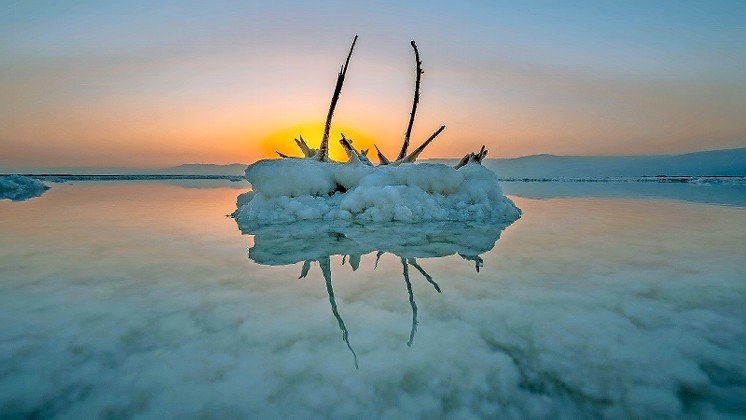Dead Sea is shrinking but it’s not exactly dying
Hundreds of people undressed and painted themselves white for a nude photo shoot last week to bring attention to the Dead Sea (Salt Sea in Hebrew), the deepest hypersaline lake in the world, 27 times denser than Utah’s Great Salt Lake, that rests 1,380 feet below sea level.
Tourists and Israelis alike love bobbing in the mineral-rich water, slathering on its healing mud and using cosmetics made from its extracts. The water and even the ambient air have proven health benefits for everything from asthma to psoriasis.
The problem is that the Dead Sea has been shrinking at an alarming pace, losing more than a meter (some 40 inches) of water per year for a total of 25 meters since the 1990s, according to EcoPeace Middle East. Giant sinkholes have swallowed up several beaches.
The photo shoot by the Dead Sea Revival Project was intended to spur action and celebrate the opening of a virtual Dead Sea Museum meant as a forerunner to an actual museum in nearby Arad.
Israel21c asked several experts to explain the Dead Sea’s troubles and what can be done to ensure the beloved lake won’t disappear. Spoiler alert: The Dead Sea surely is shrinking but it is not dying.
“The main problem is a lack of freshwater coming into the Dead Sea, in which natural evaporation is strong,” explains Isaac Gertman, a senior researcher at the National Institute of Oceanography at the Israel Oceanographic and Limnological Research in Haifa.
This happened because the landlocked Dead Sea primarily depends on the lower Jordan River, which in turn depends on the Sea of Galilee (Lake Kinneret), to get replenished. Much of this freshwater has been diverted to provide for drinking, farming and industry in Israel and Jordan.
About 700 million cubic meters of water would be needed to restore the sea level to where it was in 1900, says Gertman, who has studied the Dead Sea since 1994.
A lesser factor is the mineral-extraction industries in Israel and Jordan.
Potassium chloride and magnesium chloride are mined in large quantities by Dead Sea Works and the Arab Potash Company at the southern end of the Dead Sea. The evaporation ponds used in this process are responsible for about 35 percent of the depletion of the Dead Sea.
Are there solutions?
Gertman says that one idea was to connect the Dead and Mediterranean seas, sending runoff from the Med to the Dead and building power plants along the way. But this is not feasible economically or logistically.
About 10 years ago, another idea was floated: Building a channel from the Red Sea in Eilat to the Dead Sea, bringing desalinated water mainly to Jordan and sending the end desal product, brine, to the Dead Sea. The addition of brine could slow the rate of decrease in water level and thereby postpone the development of related problems.
However, it’s doubtful the project will go forward due to economic and political considerations.
Many Israeli scientists agree with Gertman that it may be better to build desal plants on the northern Mediterranean coast that would replenish the Kinneret with freshwater and at least partially restore the natural flow from the Kinneret to the Jordan to the Dead Sea.
Clive Lipchin, director of the Arava Institute for Environmental Studies’ Center for Transboundary Water Management, believes the Dead Sea could never again be adequately fed by the Jordan River because the water is needed by people on both sides of the border.
“This is a water-scarce region. Even with 100 more desalination plants, freshwater will always be the most sought-after resource,” he says.
Contrary to popular belief, research indicates that the Dead Sea will never dry up entirely, says Gidon Baer of the Geological Survey of Israel.
“The rate at which the level is dropping will lessen and eventually it will stabilize. The Dead Sea will not disappear,” he says. The consequences of the shrinkage will continue causing economic and environmental impacts, not all of them bad.
“When the water level drops it exposes new land at the shoreline, more salt is deposited and sinkholes form,” he says. “These features have both negative and positive aspects.”
For tourists, one negative result is that the sinkholes have destroyed several Dead Sea beaches and make it difficult to reach the waterline of surviving beaches. This could be managed by finding or building alternative routes, Baer suggests.
On the other hand, tourism could benefit from the situation.
“The features exposed have never been seen before, and the beauty of the Dead Sea is even enhanced,” says Baer.
“Before the 1980s, salt wasn’t deposited along the shoreline in such variety and quantity, and now you see it both on the shoreline and in the water. People can take advantage of that by bringing tourists to see those features.”
At least for now, with no sure solution in sight for the Dead Sea’s woes, we may have to view the situation the way we are starting to view the Covid pandemic: learn to live with it.
That’s the opinion of Jiwchar Ganor, a professor of Earth and environmental sciences at Ben-Gurion University of the Negev, and former dean of the Faculty of Natural Sciences.
“The decrease in sea level is of course human caused, but people need to drink and eat,” he says. “There is a huge population in Israel, Jordan, Lebanon and Syria. These areas are starving for water. They use all the available water, and the result is a drop in the Dead Sea level.”
The reality, says Ganor, is that the problems cannot be solved completely. “The Dead Sea will shrink but not disappear,” he concludes.

 46.0°,
Light Drizzle
46.0°,
Light Drizzle 




